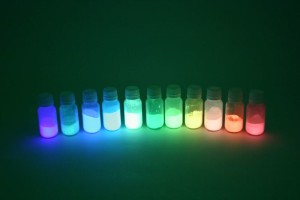
Have you ever wondered how do some fabrics glow in dark? How do galaxies painted on kid’s bedroom ceilings glow at night? Is it because of magic? No, obviously not, it is pure and simple science. The use of some pigment powders mixed and processed with certain elements in certain combinations help to create the ‘glow in the dark’ effect.
Certain specialty colorants stand apart from the regular organic pigments due to certain attributes possessed by them. One of the attribute is the ‘glow in the dark’ effect. The special substances are referred to as phosphors and glowing is sometimes called phosphorescence. Visible light is radiated by these Phosphors after they are energized. This implies that the phosphors have to be exposed to light for the required time for them to be energized and glow in the dark. This stored energy is then released by the phosphors at a slow rate for a certain period of time. While this energy is being released small quantities of light is emitted and that is the reason for the object to glow in the dark. Many chemical compounds act as phosphors; however, strontium aluminate based after-glow pigments are being used to the maximum extent.
There are endless possibilities for use of these pigments and listing all of them will be truly difficult. But if a few areas where these ‘glow in the dark’ pigments are used were to be listed then they would include canvas paintings, epoxy and resin projects, costumes and props, hats, shoes and other clothing, wall murals and ceiling and in many other commercial items such as sporting goods, exit signs, toys, stickers, fluorescent textiles etc.
One of the major applications is the ‘glow in the dark’ fabric or textiles. Textile dyes, reactive dyes and others are used to lend colour to the four main naturally sourced fabrics like cotton, wool, linen, and silk. The glowing effect is due to the inclusion of certain other additives. ‘Glow in the dark’ fabrics are made from yarn or thread of the similar type. The yarn is skin friendly and besides being woven into the fabric it can be used to sew or embroider designs which glow in the dark. The chemical processes undergone by the fabric ensures that their special attribute remains untouched even after washing and ironing though direct ironing has to be avoided. Clothes made from this fabric are used by early morning or late night joggers, campers for their tents, as party costumes, t-shirts and jump suits of kids, bed sheets and blankets and other home furnishing material.
‘Glow in the dark’ paints are another popular area where these fluorescent pigments find a wide use. Different combinations of the basic ingredients give different resultant colour combinations ranging from green to blue to red to yellow green. The ‘glow in the dark’ paints are used in a number of items such as glow cars, fishing lures, police flashlight, vehicle painting, silhouette walls, children’s rooms and lots more.
Man has created these ‘glow in the dark’ objects but nature has given us bioluminescent creatures in the form of jelly fish and fire flies that glow. Have you ever wondered why do they glow?